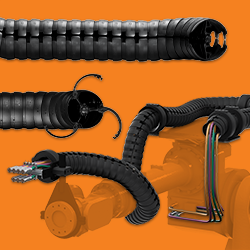I think it is realistic for a robot of some sort to be in every classroom. But, the education system will need to lead the way towards that future.
Robotics 101 at Loyola University
George Thiruvathukal | Loyola University
What type of robotics work are you doing with your students at the Loyola University? And, what are you trying to teach students about robots and their applications in the real world?
 My research—and teaching—is focused broadly on distributed systems. I’ve had a longstanding fascination with the potential for autonomous computing. One of my first projects was to build an environmental sensing network to monitor and understand climate change in the Chicago region. Whenever I teach distributed systems, inevitably at least one of my students is interested in doing something with connected systems and robots.
My research—and teaching—is focused broadly on distributed systems. I’ve had a longstanding fascination with the potential for autonomous computing. One of my first projects was to build an environmental sensing network to monitor and understand climate change in the Chicago region. Whenever I teach distributed systems, inevitably at least one of my students is interested in doing something with connected systems and robots.
Robots have applications to everything. While many conversations about robotics and artificial intelligence often lead to the, “this will replace humans” discussion, often overlooked is the great potential to augment human tasks. Of course, there is application to put robots in places where humans would otherwise be in danger. On this note, a good example of current robotics work is artificial limb extensions, primarily for those returning from war. These “bionic” arms are gradually allowing those who lost limbs to perform the much of the same functions that they could do previously. Combined with advances in A.I. and machine learning, these devices can “sense” and capture stimuli on remaining nerve endings, reintroducing a sense of touch.
Is this a specific robotics course or are you introducing robotics in other courses as an enhancement?
We offer “Advanced Robotics” in our department as a topics class. I am working on a new and exciting program that is focused on learning the basics of robotics, more of a “Robotics 101” if you will. I’m particularly fond of the robotics kits that come from Lego, often used in elementary and high-school competitions—and which was featured in the WLZ TV interview.
The robot that you had on set at WLS-TV (video link embedded), can you talk a little bit more about that robot specifically: who built it, what’s its purpose, and what’s new and exciting about it?
My son and I built this robot the night before the interview! We had been teaching the students about how to use gyroscopes in their robots. The robot I demonstrated shows how you can use the gyroscope to maintain direction. During the interview, I was jostling the robot to see whether I could throw it off course. But the gyroscope—and the program running on the robot—were used to correct its course and keep it heading on a straight path.
On the surface, there may appear to be no critical purpose to such a robot, because it is only doing a rather dedicated task—not a collection of tasks. However, if you think about what is going on with self-driving vehicles, it is clear that they need to be able to stay in-lane on the road. When students learn about the balancing mechanism of a gyroscope, they’re learning about an entire new wave of innovation and technology that we are seeing in vehicles. Although gyroscopes are hardly new (predating all of us and being well-studied in physics literature) they really trigger imagination at all ages.
In addition to learning how to program robots with gyroscopes, we’re also using other sensors, including light (for color detection), ultrasonic (for distance measurement), and touch (for pressing or bumping into other objects). The most advanced robots in the world support these same capabilities.
Walk me through the process of building a robot? Where does one begin? What problems can arise?
This process can be very involved but it always starts with what problem you are trying to solve. Robots aren’t 100% like humans, yet. They need to be programmed to do a task. Some are able to learn new tasks, but the task still needs to be introduced and written in code. For example, the robots we build for competitions address a particular challenge. This year, the theme for the elementary competition (called US FIRST Lego League, or FLL) is Animal Allies. The goal is for the robot to do biomimicry to solve various challenges on the course or field, such as gathering food, redistributing items, etc.
After identifying the problem, you need two things: mechanical capabilities and programming. In manufacturing, you may need to build a robot to do something as part of a process. For example, if it must be able lift and do at least 3 different degrees of motion along the x, y, z axes, then you need to decide what sensors are involved. If it has to tighten a screw, then it must know where the screw is located and its proximity to it. After it has detected the screw, it has to grab ahold of it or attach to it. Programming these instructions into the “DNA” of a robot is critical to the execution of a desired task.
In terms of problems, there can be many. In our competitions a big “hurdle” is that the robot, while driving or moving around, encounters an obstacle. If the robot is operating autonomously it’s basically stuck and needs to be rescued. Sometimes it needs to be restarted. Either way, human intervention is still very much a part of the picture.
Please tell us how you are using robotics in the classroom? Are you building robots? Designing them? Programming them?
Yes, I am building them. Most of the elementary school work is done with Lego EV-3 systems. I am also doing work with high school and college student using a more advanced system called Tetrix that uses an Android phone for the robot’s brain. It also uses Android for doing remote operation of the robot to write programs that assist humans.
Robotic manufacturing is grown big time in the past decade, so what industries do you think will be most affected? What are the human advantages of having robots around and what are some of the drawbacks, if any?
Robots are going to have major implications, not just in traditional manufacturing but in disciplines where you would think only highly-trained academic specialists are needed. I see big changes coming to science and medicine, which is already seeing the use of nanotechnology (nano-robots) for understanding heart disease. Robots can also be used to do ultra-precision maneuvers at a slow rate. There is no reason to believe that many of the most complicated surgeries can eventually be done by a robot under doctor supervision.
As with any technology, there are advantages and disadvantages. As mentioned earlier, robots can be substituted in situations where humans would be in harm’s way. Recently I saw that R&D is being done at Berkeley (UC Berkeley) to build robots that are able to swim like turtles and go to check on whether a bridges infrastructure is still holding up to a safe standard. More than simply observing the structure though, there are applications for robots to handle repairs by manually operating robotic arms.
How would you like to see the future of robotics in the classroom evolve? Not long ago we hoped for a computer in every classroom … is a robot in every classroom a realistic goal and would that be the direction you would envision?
I’d like to see robotic technologies continue to stimulate imagination and creativity all over the world. I have seen first-hand the positive influence robotics has on students of all ages. It is a great way to bring abstract ideas of math and science to life and enhance student engagement.
It is not cost-prohibitive to get started with this technology and can often be addressed through fundraising. Lego robots cost a few hundred dollars (USD). Many children already show an affinity to play with Legos and bricks, and now with robotic technologies being introduced through school programs, students will actually enjoy the curriculum.
I think it is realistic for a robot of some sort to be in every classroom. But, the education system will need to lead the way towards that future. I’ve long said that, “We’re good at doing the 3 R’s (Reading, wRiting, and aRithmetic), and I want Robotics to be the fourth!” Robotics is not the only way to learn computer science and engineering, but it should be at least one of the things students learn at some point in their life.
How can other teachers / professors find the information and support they need to get more robots into the classroom?
They can start by contacting me! I’m always happy to help people get started on how to introduce robotics into the classroom. The more educators involved, the better our youth will be prepared for a world where robots are less the stuff of science-fiction and largely a part of reality.
George Thiruvathukal, IEEE Member and Professor of Computer Science at Loyola University Chicago
George is an IEEE Member, a Professor of Computer Science at Loyola University Chicago and Visiting Faculty at Argonne National Laboratory in the Mathematics and Computer Science Division, where he collaborates in high-performance distributed systems and bioinformatics.
References:
Profile page on George: http://luc.edu/cs/people/ftfaculty/gkt.shtml
IEEE Website: http://www.ieee.org/
The content & opinions in this article are the author’s and do not necessarily represent the views of RoboticsTomorrow
Featured Product

